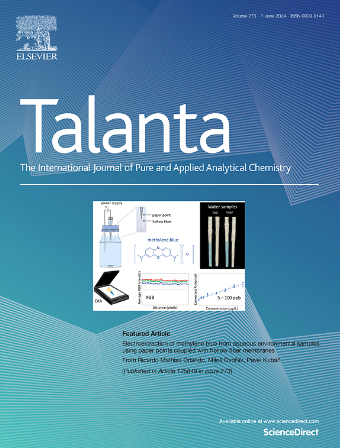Magnetic solid phase extraction based on restricted access molecularly imprinted polymer with dually coated for enantioselective determination of tramadol in human plasma by capillary electrophoresis with ultraviolet detection
IF 5.6
1区 化学
Q1 CHEMISTRY, ANALYTICAL
引用次数: 0
Abstract
A restricted-access magnetic molecularly imprinted polymer with dually coated of hydrophilic monomer and bovine serum albumin was synthesized, properly characterized by different techniques, and used as adsorbent in Magnetic Solid Phase Extraction (MSPE). Furthermore, a simple and efficient method employing capillary electrophoresis with ultraviolet detection was developed and validated for the enantioselective determination of tramadol (TRM) in human plasma. The optimized conditions were 25 mM phosphate background electrolyte at pH 9.05 using 0.01 g of sulfated-β-cyclodextrin as chiral selector, hydrodynamic injection at 40 mbar for 4 s, voltage at 10 kV, temperature of 25 °C, and a fused silica capillary with an effective length of 50 cm. In these conditions, (−)-(1S,2S)-TRM exhibited a migration time of 8.48 min and (+)-(1R,2R)-TRM of 9.50 min. Several factors affecting the MSPE were optimized, achieving extraction recoveries/relative standard deviation of 99.6 ± 8.1 % by means of 100 μL of human plasma at pH 8, 1000 μL of acetonitrile as eluent, 20 mg of adsorbent, 200 μL ultrapure water as washing solvent, and 60 s of stirring. The method was linear (range of 100–3000 ng mL⁻1), selective, and accurate, with a limit of quantification and detection of 100 and 50 ng mL⁻1, respectively, for both enantiomers, allowing their determination in real human plasma samples. This method presents an important alternative for monitoring athletes and in forensic applications.

求助全文
约1分钟内获得全文
求助全文
来源期刊

Talanta
化学-分析化学
CiteScore
12.30
自引率
4.90%
发文量
861
审稿时长
29 days
期刊介绍:
Talanta provides a forum for the publication of original research papers, short communications, and critical reviews in all branches of pure and applied analytical chemistry. Papers are evaluated based on established guidelines, including the fundamental nature of the study, scientific novelty, substantial improvement or advantage over existing technology or methods, and demonstrated analytical applicability. Original research papers on fundamental studies, and on novel sensor and instrumentation developments, are encouraged. Novel or improved applications in areas such as clinical and biological chemistry, environmental analysis, geochemistry, materials science and engineering, and analytical platforms for omics development are welcome.
Analytical performance of methods should be determined, including interference and matrix effects, and methods should be validated by comparison with a standard method, or analysis of a certified reference material. Simple spiking recoveries may not be sufficient. The developed method should especially comprise information on selectivity, sensitivity, detection limits, accuracy, and reliability. However, applying official validation or robustness studies to a routine method or technique does not necessarily constitute novelty. Proper statistical treatment of the data should be provided. Relevant literature should be cited, including related publications by the authors, and authors should discuss how their proposed methodology compares with previously reported methods.
 求助内容:
求助内容: 应助结果提醒方式:
应助结果提醒方式:


